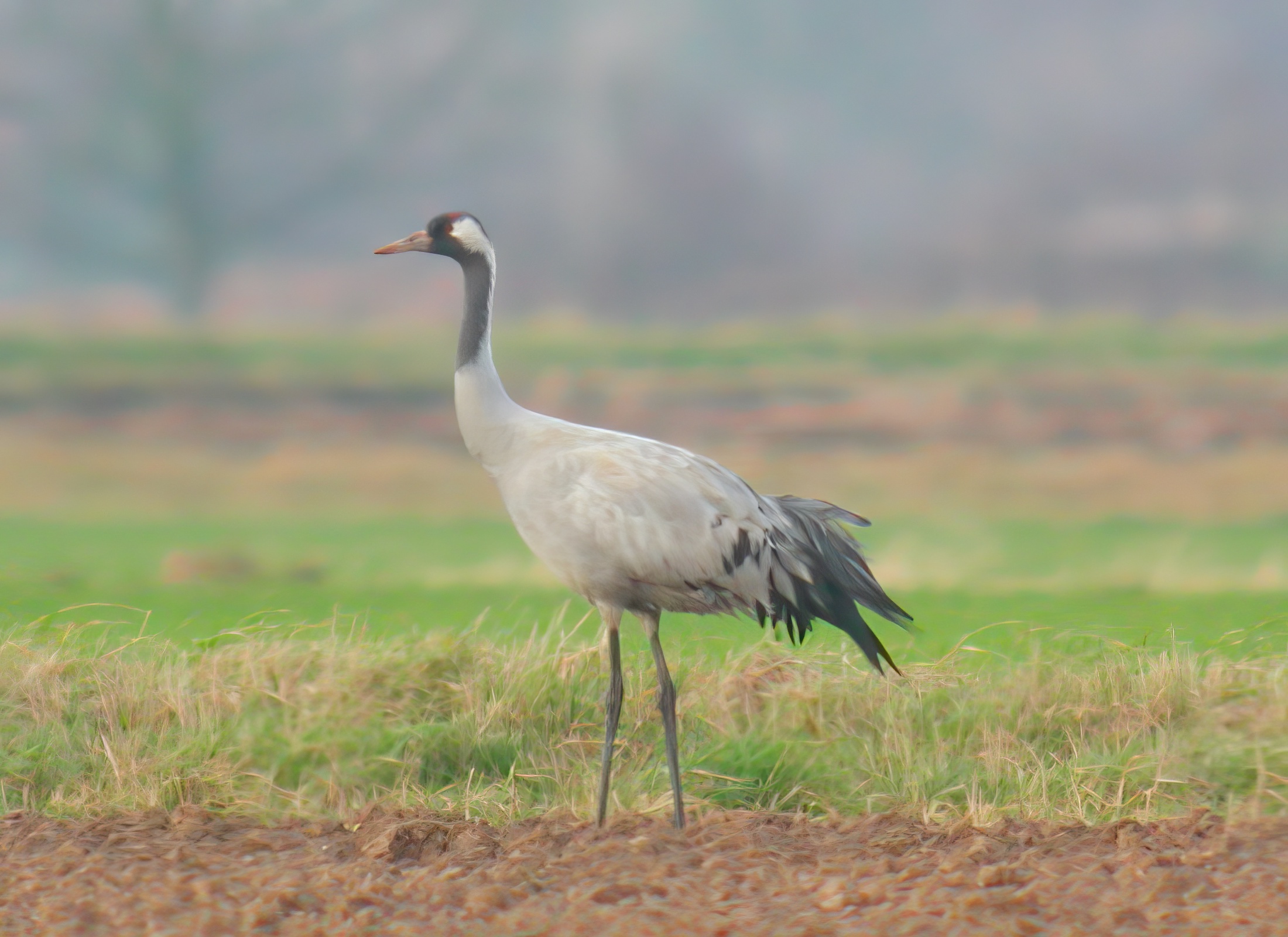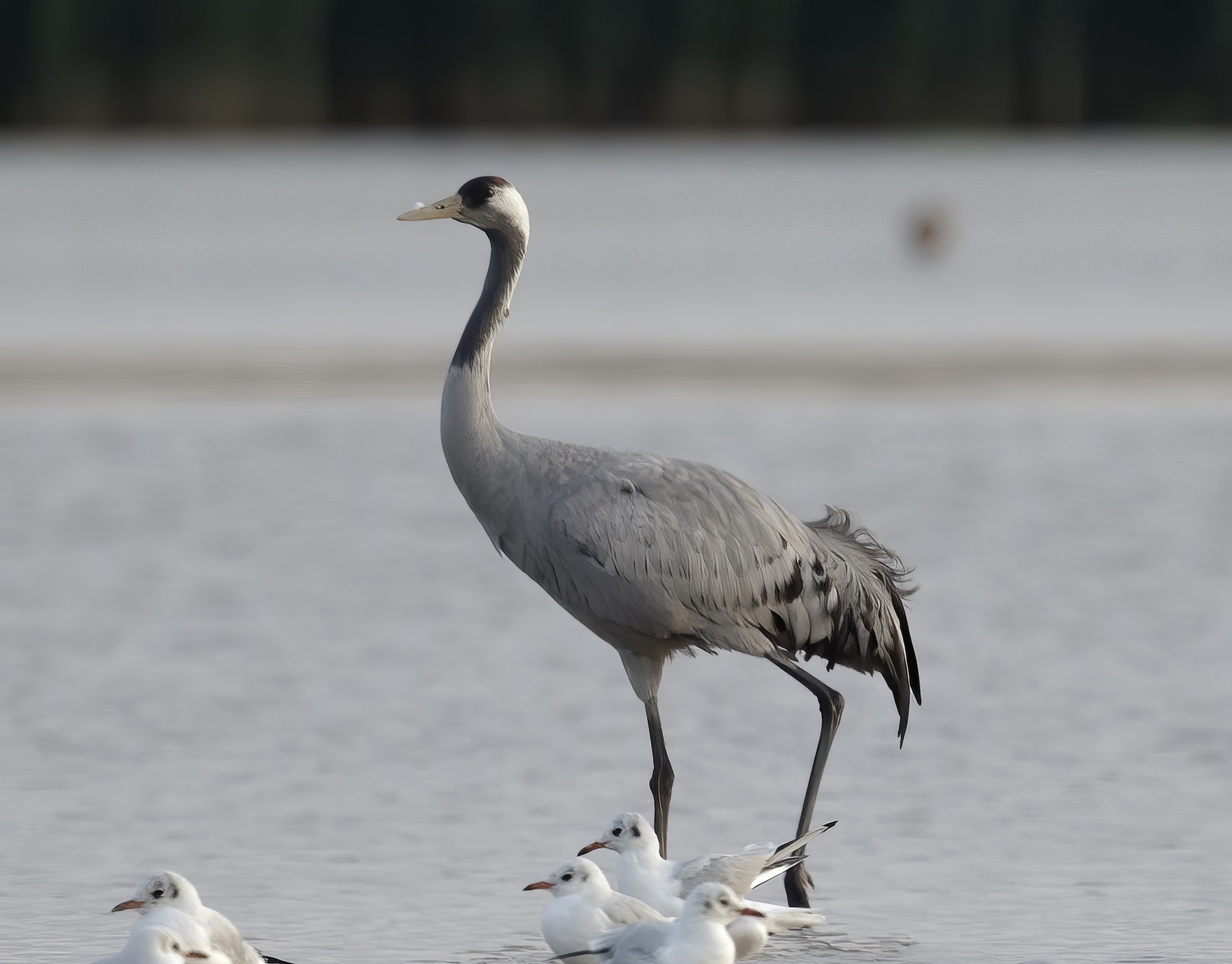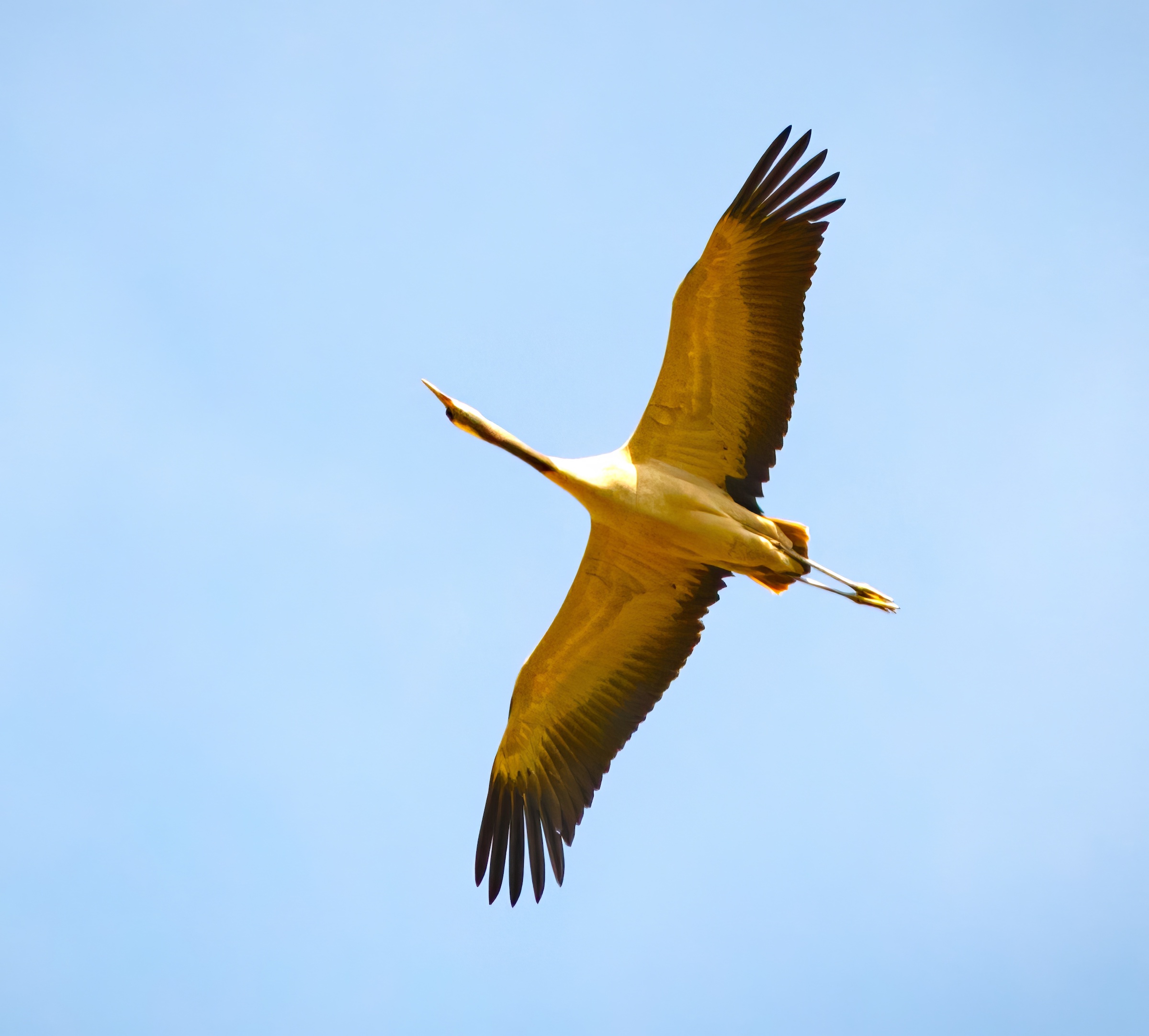Common Crane Grus grus



Lorand and Atkin (1989) give a good account of the history of Common Cranes in Lincolnshire. They have bred in adjacent South Yorkshire, Cambridgeshire and Norfolk in recent years but up to 2019 had only appeared as a scarce migrant in Lincolnshire. This changed in 2020 when out of the blue a pair bred at the LWT reserve at Willow Tree Fen and in August 2020 one chick successfully fledged, the first to do so for more than 400 years (See Capper (2020), below). They are more familiar as scarce but regular migrants in the county, and have turned up in most months of the year. The majority occur during March-May with far fewer in the autumn; most are seen flying over coastal migration hotspots. In recent springs the first birds have generally been noted in March, an exception being 2012 when eight flew over Bourne on February 17th. Most times 1-5 birds have been seen but occasionally in larger flocks: seven (May 2004, Apr 2013), eight twice (December 2006, October 2013), nine (April 2017) and 11 (April 2018). The last birds of the year are seen in October-November in smaller numbers and occasionally singletons have overwintered.
Finder’s report: Common Crane, November 4th, 1966, Skegness.
by E. J. Mackrill and L. J. Hurst.
Note: account based on the original BBRC submissions; it is the earliest report that we have of Common Crane, and at a time when it was a submissible species. The summary from the RC (BBRC) that year was that after the remarkable influx at the end of October 1963 (c. 500) the eleven records in 1966 may seem quite modest. Three spring records were noteworthy, and the total is, in fact, the second highest since at least 1958 and probably very much earlier than that.
Circumstances
I (EJM) was riding along in a bus when I observed a huge bird stood in a field some distance away and as I have seen several on the continent I identified it immediately as a Crane, Megalornis grus*, from its characteristic stance, movement of neck when feeding etc. When I arrived home, I phoned my friend who went out to see it. I also told several other local observers including R. B. Wilkinson of Gibraltar Point Bord Observatory, but when they arrived it was too dark to see. The weather conditions at the time were very beneficial to any drift migration and the Crane had obviously drifted over in the strong SE winds and came down in the fog as soon as it reached land
(*Synonym of Grus grus, used in the Rare Bird report up to 1964, Grus grus thereafter.)
Description
The bird when first observed at considerable distance appeared very grey on its back and paler underneath, with dark legs and bill. It appeared to be approximately twice the size of a Grey Heron, Ardea cinerea. It was feeding in a stubble field with the characteristic curved neck and horizontal stance of feeding Cranes, with the occasional look around for enemies. When alarmed it straightened its neck and walked with slow deliberate steps before quickening them prior to taking flight. In flight head and legs were extended horizontally (not downwards as I have observed in Storks) as it flew away with slow wing beats.
I returned, early on November 5th and observed the bird further. A reasonable description was taken before it took flight and headed south not to be seen again.
Upperparts – the back was predominantly grey though becoming slightly brownish towards the centre. The folded wings were slightly greyer than the back, though still suffused with brown. The neck was greyish-brown and slightly paler than the back leading up to the head which was almost entirely brown. Eye colour not observed, and the bill appeared greenish-brown.
Underparts – greyish-brown neck merged into the buffish-grey belly and thighs, which made the bird look considerably paler underneath from a distance. Legs were very long and blackish.
Aging – the bird appeared much darker than others I had seen, and this fact combined with the absence of black tail plumes led me to the conclusion that the bird was an immature.
Breeding Cranes in Lincolnshire in 2020
by Matthew Capper, Lincolnshire Wildlife Trust.
Note: this article appeared in the Lincolnshire Bird Report 2020 and records the events leading to the first breeding of Common Crane in Lincolnshire for several centuries. The most recent RBBP Report, that for 2019, estimated that there were 38-47 breeding pairs of Common Crane in that year, together with at least another 11 pairs of non-breeding birds. It seems likely that this species will continue an upward trajectory as a breeding bird..
Common Crane Grus grus was once a common sight in the UK but hunting and the loss of wetland habitat led to their disappearance as a breeding species around 400 years ago. Birds returned to the UK in 1979 and the first nesting attempt was in 1981 at Horsey in the Norfolk Broads. They bred successfully the following year, when one chick was fledged. They are long-lived and breeding attempts are often unsuccessful, meaning that this embryonic population took 20 years to reach double figures. It wasn’t until 2007 that they began to spread out from their Norfolk stronghold, when 10-12 pairs bred in two further counties. In recent years, however, numbers have increased markedly, further boosted by a reintroduction project, centred on the Somerset Levels. In the east of England, Cranes colonised the Nene and Ouse Washes to the south of Lincolnshire and the Humberhead levels to the north-west. The Humberhead birds winter in East Anglia leading to an increase in sightings in the county as birds commute between the two areas and other birds spill over from the south, looking for available territories.
Today, the Lincolnshire Fens are a shadow of the once extensive mires, swamps and shallow lakes that extended across much of the south-east of the county. Over 99% of the original fenland has been lost in favour of large open fields, crisscrossed by deep drains. In 2009, Lincolnshire Wildlife Trust acquired Willow Tree Fen, an area of farmland that was converted from growing cereals and beans to a new wetland, recreating some of the lost fenland habitat and making a significant addition to the Trust’s suite of reserves. Fen habitat has been quickly recolonised and species such as Marsh Harrier Circus aeruginosus, Redshank Tringa totanus and Lapwing Vanellus vanellus all breed in significant numbers; Bittern Botaurus stellaris is now also noted with some regularity. At 112 hectares, Willow Tree Fen is large but has a track bisecting the reserve and other paths and hides, so it was assumed that it would be unsuitable to host both a pair of breeding cranes and visitors. Cranes are notoriously sensitive to disturbance and the arrival of a pair at RSPB Lakenheath in 2007, for example, led to a complete redesign of the reserve, removing planned access to nearly half of the site.
Plans changed in 2020 with the arrival of COVID-19 and the resultant UK lockdown from March 23rd. Conditions at Willow Tree Fen, now devoid of visitors, were immediately suitable for Cranes and exactly one month later, on April 22nd, a pair arrived, most likely from the nearby Nene Washes. They stayed put and were joined the next day by a second pair, which they vigorously evicted over the course of the next few days. Display was first noted on April 23rd and the decision was taken to formally close the reserve. South East Lincolnshire Warden John Oliver swung into action to establish a nest protection scheme, which was up and running just two days after the birds arrived. By the end of the breeding season, 25 volunteers had contributed over 1,500 hours of their time – an incredible effort.
On May 5th, the behaviour of the pair changed. Only one bird was seen at a time, indicating that the other was on the nest, incubating eggs. Five days later, the Prime Minister announced a conditional plan for the easing of lockdown, but the decision was taken to keep Willow Tree Fen closed and a watch point was established by the bridge at the entrance to the reserve. The behaviour of the adults changed again on June 2nd, and on June 15th it was confirmed by a remote camera that there was a single chick being cared for by the parents. At this point, the Trust shared the news more widely and it attracted a good deal of publicity, including items on BBC Look North and Radio 4’s Farming Today. The parents were most likely first-time breeders but proved to be both attentive and protective, keeping the young bird close to the nest site and within the nearby wetland until June 25th when they moved to the adjacent Railway Field. This matches the pattern of behaviour seen at other sites in the UK such as the Humberhead Levels where young chicks are generally kept close to the nest at first and then graduate to nearby farmland as they get older. The layout of Willow Tree Fen is such that fences and ditches form barriers to this movement and so gates were opened and later that winter, new land bridges were created over ditches, to aid connectivity in future years.
The first flight was noted on August 12th and the parents and chick began to feed on neighbouring farmland, returning to the site to roost in the evenings. They remained at Willow Tree Fen until October 11th when the family party left to spend the winter with the wider crane population, most likely on the Ouse and Nene Washes. It represented the first breeding Common Cranes in Lincolnshire for over 400 years and the chick was one of 23 fledged nationally – a record breaking year involving 64 breeding pairs. Chick mortality can be high during the first year and so it was especially pleasing to see all three birds return to Willow Tree Fen on January 22nd 2021. With birds being site faithful, it is likely that breeding attempts will occur at Willow Tree Fen for the foreseeable future. As with Lakenheath in 2007, this has prompted a discussion about how the Trust can host both visitors and Cranes going forward. In the short term, the needs of the birds will come first but in time, it is hoped that we can redesign the site to allow some access and public viewing whilst maintaining the privacy that the Cranes require.
References
Capper, M. (2020). Breeding Cranes in Lincolnshire in 2020. Lincolnshire Bird Report 2020: 242-243.
Eaton, M. and the rare Birds Breeding Panel (2021). Rare breeding birds in the UK in 2019. British Birds 114 (11): 646-704.
Smith, F. R., and the Rarities Committee (1967). Report on rare birds in Great Britain in 1966 (with 1964 and 1965 additions). British Birds 60 (8): 309-338.
(Original account as per new Birds of Lincolnshire (2021), included and updated September 2022; further updates July 2023)

